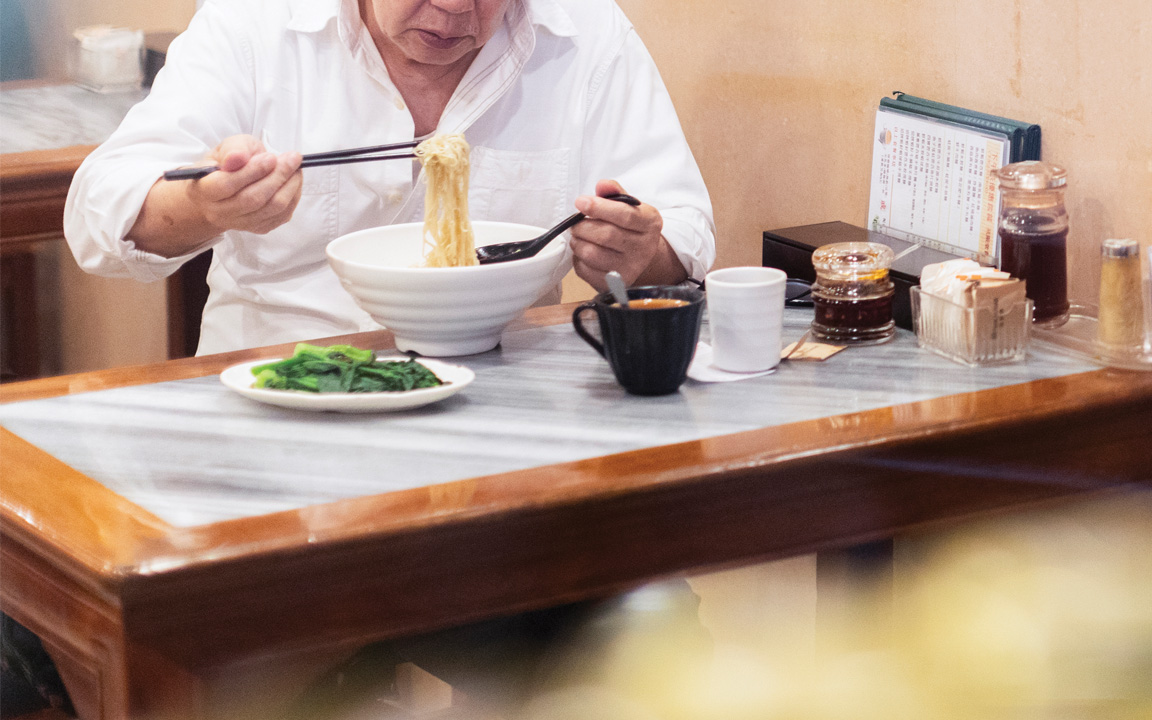For many older Hongkongers, springy bamboo noodles and egg yolk and lotus seed paste mooncakes are quintessential comfort foods. These delicacies are made from loose flour, which culinary artisans transform into a variety of textures – crispy, springy, tender – using their hands and even the full weight of their bodies. As the end of the year approaches and reunion feasts commence, we visit “Pat Sin”, a bakery known for its handcrafted Chinese pastries since 1966, and “Kwan Kee”, where the younger generation is carrying on the legacy of bamboo noodle making.

Pat Sin Bakery
Sham Shui Po is one of Hong Kong’s most vibrant areas, a place where crowds of people flow like a river all year round. Many of them make their way to Pat Sin Bakery (Pat Sin) on Nam Cheong Street, lured by the exceptional aroma of freshly baked goods and a vast, delightful array of pastries and snacks that spoils connoisseurs for choice.
Wife cakes, walnut cookies and an assortment of other delicacies make up Pat Sin’s staples, while a diverse selection of traditional wedding pastries such as lotus seed paste red pastries, mung bean paste yellow pastries and preserved egg pastries adds to the bakery’s offerings. A particularly delightful surprise is Pat Sin’s range of traditional local snacks, such as banana rolls, phoenix bites and red bean curd crisp flakes, many of which have vanished from most if not all other local bakeries.
It’s the Mid-Autumn Festival season, and the entrance is crowded as trays of freshly baked mooncakes are stacked inside for cooling and packaging. Customers may choose from as many as 10 different flavours. Meanwhile, five pastry chefs are busy kneading dough, filling pastries and baking, churning out most of Pat Sin’s traditional pastries in a compact kitchen measuring less than 400 square feet.
Cheung Tsz Cheong, a seasoned man in his 50s and the second-generation owner of Pat Sin, gazes steadily and calmly at the hectic surroundings. “I still remember how our whole family would come to help make mooncakes in the run-up to the Mid-Autumn Festival, and those mooncake boxes were piled from floor to ceiling,” he reminisces. Today, now that he has taken up the business founded by his father, he insists on handmaking traditional Chinese pastries in an effort to preserve this priceless culinary heritage.
“I wouldn’t say our handicraft necessarily produces better taste than those large factories using machines. After all, ours are human hands – sometimes they roll out thinner crusts, sometimes thicker. But it’s the personal touch that makes us special, not to mention the use of premium ingredients and our refusal to use preservatives. Freshness is the key to good taste,” Cheung explains.
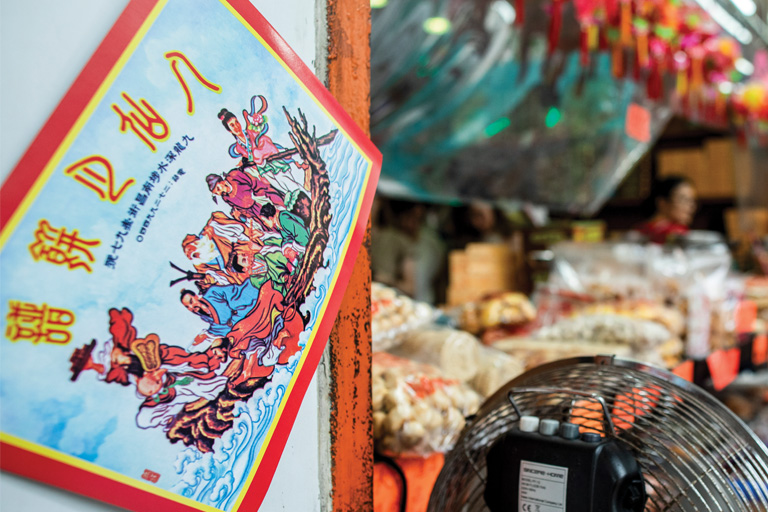
I wouldn’t say our handicraft necessarily produces better taste than those large factories using machines. After all, ours are human hands – sometimes they roll out thinner crusts, sometimes thicker. But it’s the personal touch that makes us special.
Rising with the times
This traditional patisserie has its roots in the renowned Pat Sin Chinese Restaurant, established in 1966 on Cheung Sha Wan Road. Back in those days, many Chinese restaurants offered not only dim sum and other dishes, but also Western and Chinese pastries. Pat Sin (“eight immortals”) – which got its name because there were eight shareholders – was no exception.
Cheung Tsz Cheong’s father, Cheung Cheung, oversaw the Chinese pastry section at Pat Sin Chinese Restaurant, and he was passionate about making delectable offerings. But in the late 1970s, competition among eateries in Hong Kong intensified and business at Pat Sin started to decline. The restaurant’s shareholders considered closing down, but the Chinese pastry business was still robust, so they’ve decided to keep it. Because the shareholders trusted Cheung Cheung, they made him a partner.
In 1978, Pat Sin moved to its current location. In those early years, Hong Kong’s economy was booming, but big corporations had not yet ventured into the Chinese pastry market. Meanwhile, Chinese etiquette for exchanging and reciprocating gifts remained strong in Hong Kong, and Chinese pastries and seasonal items made perfect gifts – all positive factors fuelling Pat Sin’s growth.
According to Cheung Tsz Cheong, Chinese wedding custom dictates that the groom’s family present wedding pastries to the bride’s family, who then shares the pastries with relatives and friends to spread the joy of their union. Today, people are accustomed to sharing joy by distributing cake vouchers, which offer the dual benefit of convenience and flexibility. Some couples also prefer offering relatives and friends Western-style cakes.
“In the past, however, wedding pastries had to be Chinese-style pastries,” explains Cheung. “And the groom was required to deliver the pastries to the bride’s family in person, carrying the exact weight of pastries he purchased.” Wedding pastries carry auspicious meanings: mung bean paste yellow pastries for wealth; lotus seed paste red pastries for good luck; assorted nuts white pastries for a long-lasting marriage; preserved egg pastries for the birth of a son; and walnut cookies for marital harmony.
Presenting mooncakes to relatives, friends and business acquaintances is one of the most cherished of Chinese traditions, symbolising the joy of togetherness. Cheung says in the past, though, giving gifts during the Mid-Autumn Festival placed a significant financial burden on many families. This gave rise to the concept of “mooncake clubs”, by which participants pooled small monthly contributions to buy mooncakes months ahead of the festival. For bakeries, “mooncake clubs” provided funding and facilitated production planning.
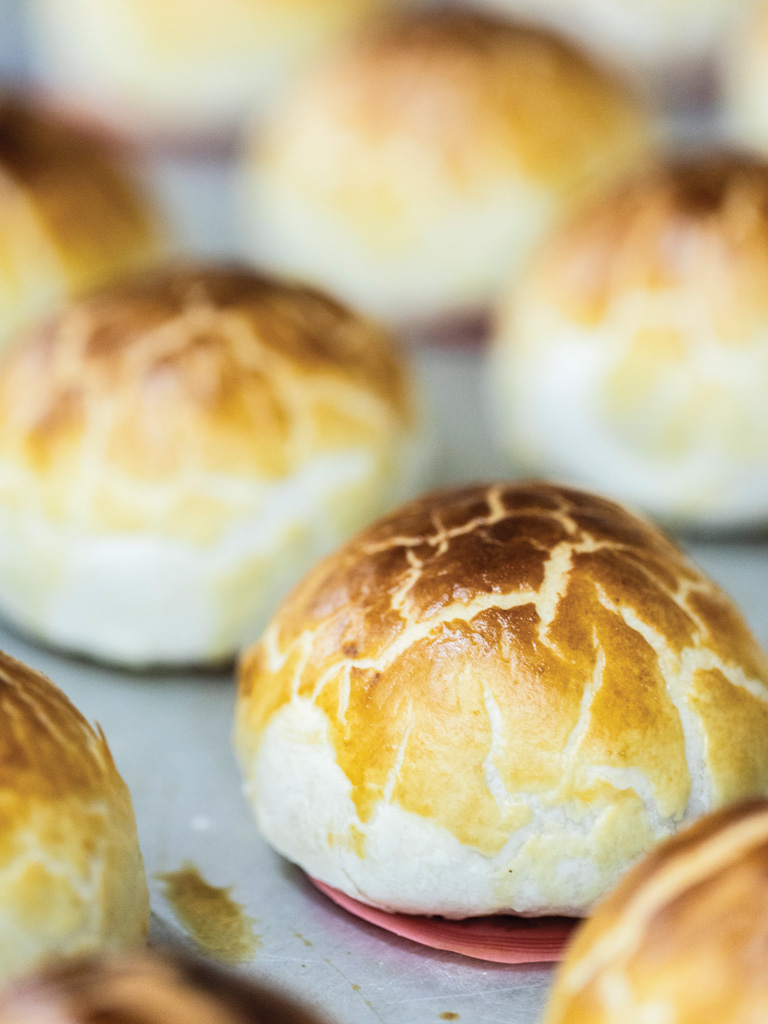
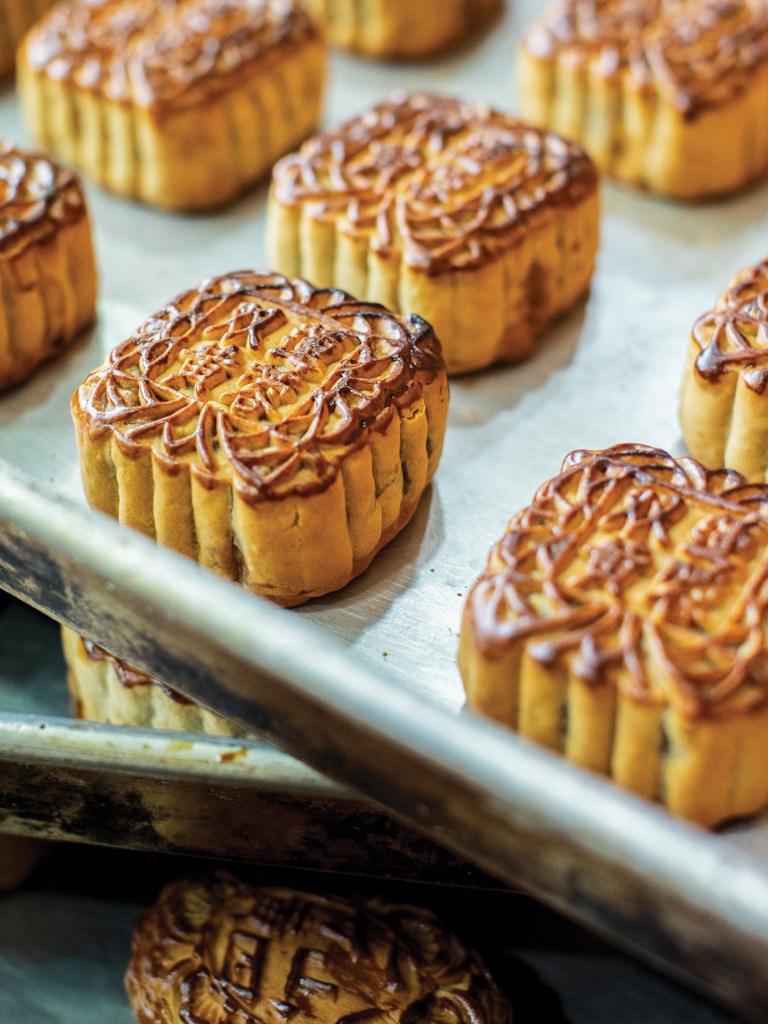
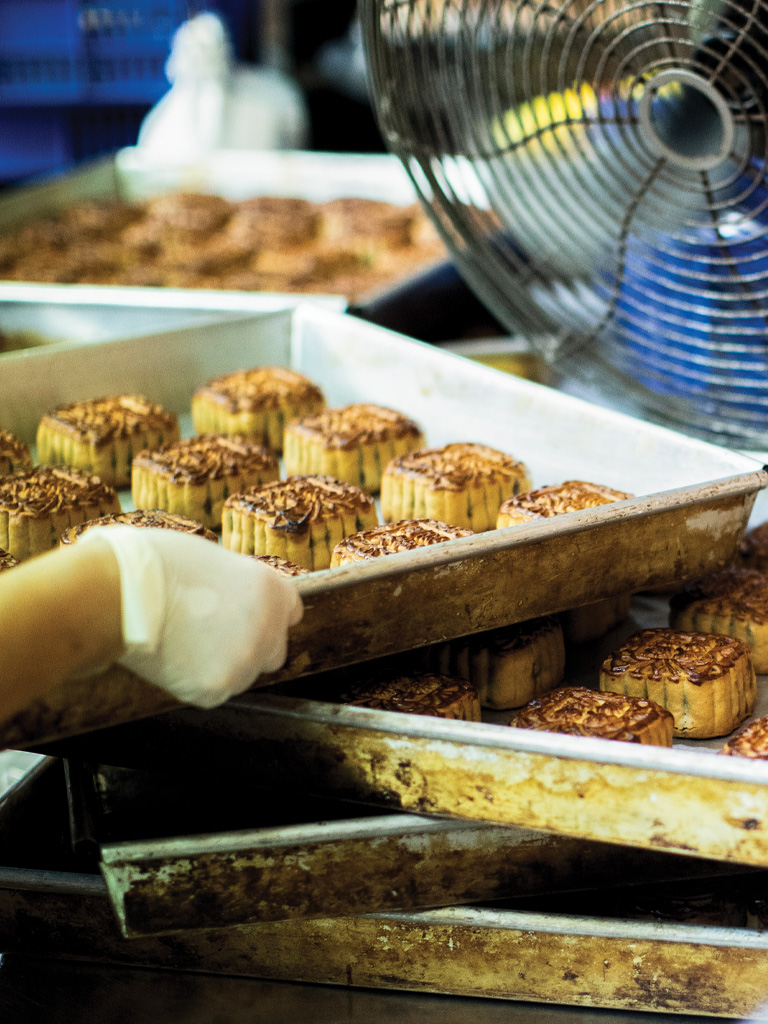
In the months leading up to the Mid-Autumn Festival, Pat Sin would begin receiving reports from various mooncake clubs on set orders, helping them estimate the quantities of the ingredients they needed to procure. “Back in those days, it was truly a spectacular scene. The biggest mooncake club would place more than 2,000 orders of mooncakes, with each order accounting for 10 boxes. Just before the Mid-Autumn Festival, everyone would come with their order slips to redeem their mooncakes. The sound of staff shouting out customers’ orders was deafening. All the young and energetic members in the shop would pitch in to help,” recalls Cheung fondly.
Cheung Cheung had four children. His eldest son, Cheung Tsz Wing, began his apprenticeship at Pat Sin in his teens to master the art of traditional pastry-making. Cheung Tsz Cheong and his other two siblings pursued different professions as they grew up.
In the 1990s, Pat Sin faced new challenges. Food and beverage conglomerates began to rise in prominence, establishing automated factories for the quick production of traditional and Western pastries. This trend also coincided with the decline of mooncake clubs. To respond to these changing market conditions, Cheung Cheung introduced individually packed mooncakes, an innovation that made them more affordable. By combining traditional craftsmanship, a diverse range of pastries and a new strategy of creating larger turnover at lower prices, he was able to keep the famous brand running.
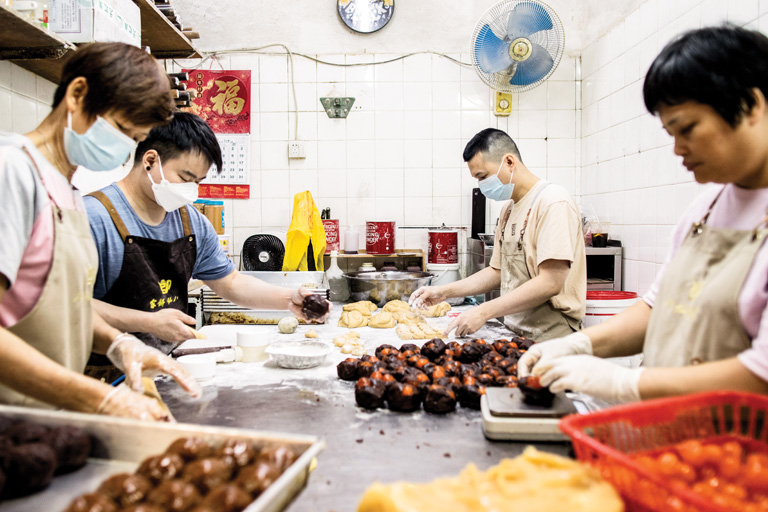
The old hands in charge
Cheung Tsz Wing, who had been in charge for years, retired a few years ago, so Cheung Tsz Cheong took over management of Pat Sin. By this time, the bakery’s daily operations were in the hands of a skilled and reliable eight-person team, which allowed the younger Cheung to take a more macro approach to management.
Supervising the team is Sister Yip, a Pat Sin employee for more than a decade who oversees the storefront. Helming the pastry-making is Master Lee Kwok Wing, or Ah Wing, a talented pastry chef who was mentored by Cheung Tsz Wing.
The store opens for business every morning at 8:00am. Ah Wing arrives at 7:00am to prepare ingredients and fillings for the day, often working until 6:00pm in the evening.
“Besides the mooncakes, we have to make six to seven types of pastries each day – wife cakes, walnut cookies, egg yolk pastries, ordinary cakes... these are our staples,” Ah Wing remarks.
There are four workers in the bakery. Some knead the dough, some do the filling and Ah Wing oversees baking. “We rely on experience rather than a timer to monitor baking time as we use a traditional oven instead of an electronic one,” says Ah Wing, watching the oven closely. Standing by a traditional oven for more than 10 years has helped him master this delicate art.
On this busy day during mooncake season, Ah Wing is leading the team in rolling out an array of mooncakes as well as crafting traditional Chinese pastries. In a single day, this packed kitchen can produce over 400 mooncakes in approximately 10 flavours. On top of popular choices such as white lotus seed paste with two yolks and yellow lotus seed paste, Pat Sin offers “chicken oil” mooncakes with two yolks. In recent years, they have also introduced innovative flavours like red bean paste with mandarin peel.
Bakeries today rarely make chicken oil mooncakes. Ah Wing explains that these mooncakes do not actually contain chicken oil; instead, they use mung bean paste, which has a yellowish colour resembling chicken oil.
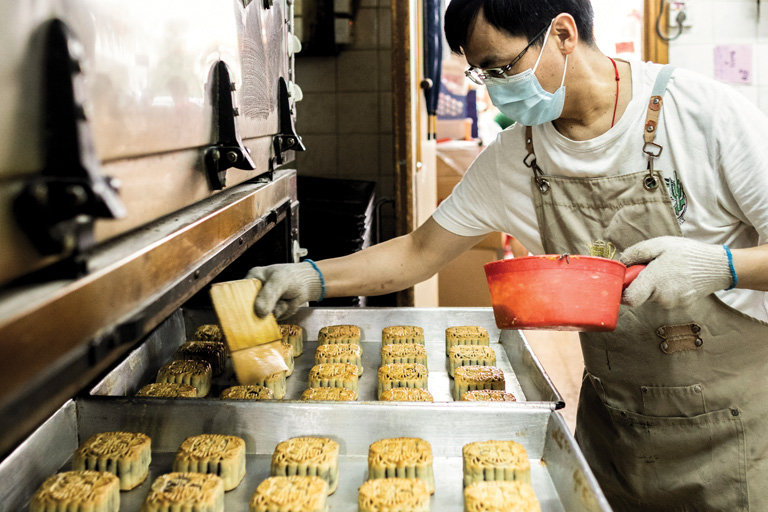
Bakeries today rarely make chicken oil mooncakes. Ah Wing explains that these mooncakes do not actually contain chicken oil; instead, they use mung bean paste, which has a yellowish colour resembling chicken oil. Despite the bakery’s wide variety, Ah Wing personally prefers the classic flavour of Chinese ham mooncake with assorted nuts.
“This filling offers the most diverse texture. In addition to the traditional assorted nuts mixture of melon seeds, walnuts and sesame, it also has ingredients like BBQ pork, ham and lemon leaves. We use the finest Hong Kong–produced Crown peanut oil for all our mooncake crusts. For the assorted nuts mooncakes, we use Japanese sesame oil. Additionally, we have our own production facility for preparing white lotus seed paste, yellow lotus seed paste and other fillings in large pots. When your ingredients are of premium quality, it is natural that many people appreciate them,” Ah Wing says with pride.
When Ah Wing first joined Pat Sin, he spent his early years selling pastries. After observing him for a long time, Cheung Tze Wing asked Ah Wing if he would be interested in learning how to make pastries. Ah Wing jumped at the opportunity. Though he dislikes cooking, he loves handcrafting pastries.
Nowadays, making wedding cakes and mooncakes has been recognised as an intrinsic part of cultural heritage in Hong Kong. Ah Wing, however, is quite humble about his craftmanship. He says, “The craft is not difficult to learn, but it takes practice to perfect. It is important to remember the ingredients of each traditional pastry. There is no room for mistakes.” He takes his work so seriously that he keeps his fingernails trimmed short and neat.
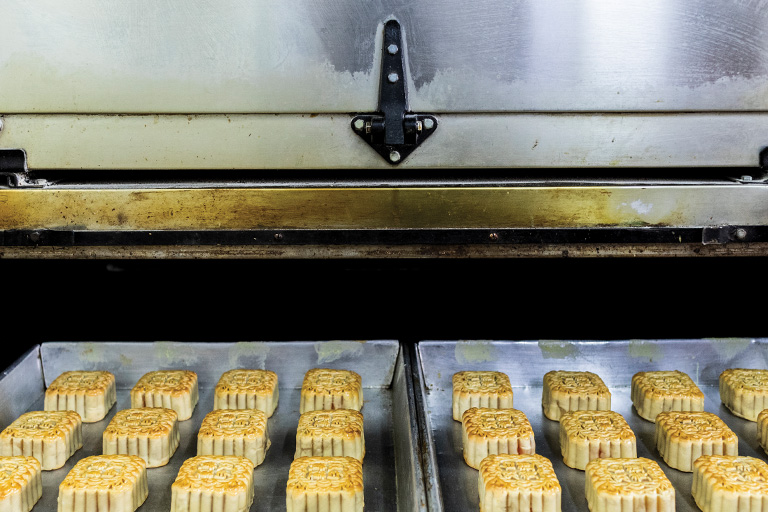
We rely on experience rather than a timer to monitor baking time as we use a traditional oven instead of an electronic one.
Baking for a new generation of customers
In recent years, Cheung Tsz Cheong has frequently received suggestions to automate Pat Sin’s pastry production. “They say it would cost roughly 1 million Hong Kong dollars to acquire the full equipment set. I responded that it would make more sense to invest money in our team instead of buying machinery,” he says.
That day, while making mooncakes, Ah Wing and his colleagues also whip up some mini phoenix bites. Later on, they make piggy biscuits and Chinese chess cakes using the remaining mooncake ingredients. The bakery keeps grinding out freshly made Chinese pastries – some soft and chewy, others crispy and fragrant – almost like a magic trick.
Customers can be heard calling out their orders in the shop. Elderly couples and trendy young people alike are in the crowd.
“Six hundred grams of phoenix bites, please!”
“Hey, grab me four boxes of red bean paste mooncakes!”
“Are there any wife cakes left?”
Cheung Tsz Cheong explains that it has not been easy to run the business after the COVID-19 pandemic. But seeing an increasing number of young people showing interest in traditional culinary experiences makes him hopeful.
Hanging on the wall is the 60-year-old Pat Sin signboard in glittering golden paint. Its clever design seamlessly integrates the Chinese characters “Pat Sin” with the English abbreviation “PS”. Every time Cheung Tsz Cheong turns to look at the signboard, he cannot help but admire the wisdom of his predecessors and the amazing charm of Chinese culinary tradition.
He cannot help but admire the wisdom of his predecessors and the amazing charm of Chinese culinary tradition.
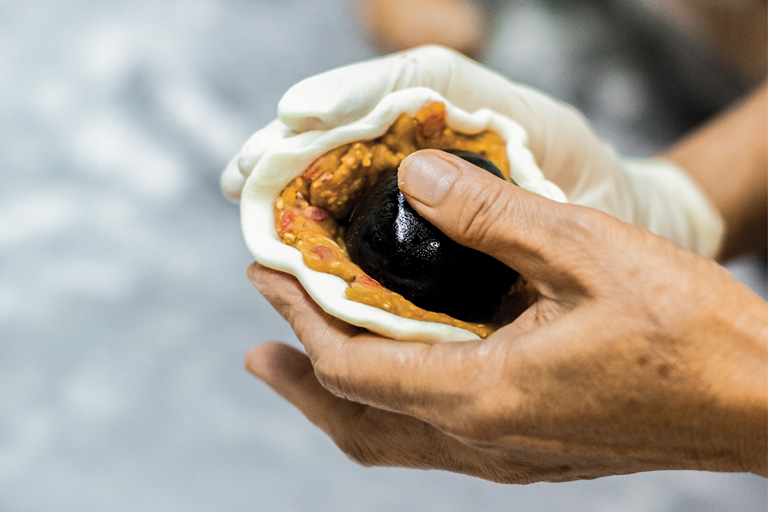
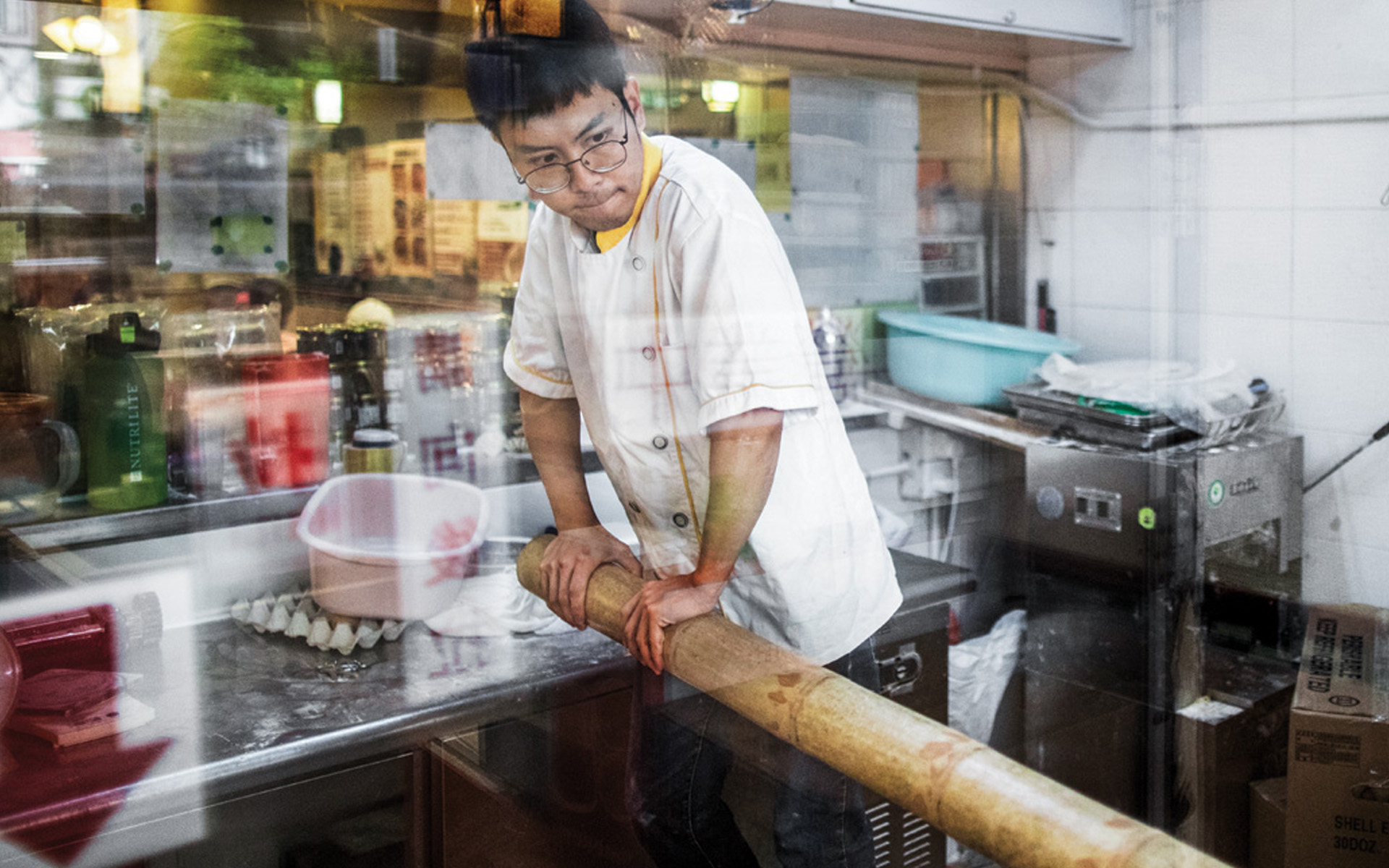
Kwan Kee Bamboo Noodles
Marco Li was fascinated watching his father work on bamboo noodles for the first time. Riding on one end of a two-metre-long bamboo pole the width of his fist, he would bounce up and down, gently kneading the dough with the bamboo.
Chuckling, Marco says, “It looked like riding a seesaw alone.” But it was only after he started apprenticing under his father that he realised it was not so easy. “Initially, it was tough getting used to the physical exertion. It’s a vigorous aerobic exercise, especially for me with my history of Meniere’s disease since childhood, which made me prone
to dizziness.”
Bamboo noodle making involves striking and kneading dough with a bamboo pole, colloquially known as “ngan” in Cantonese. The action requires bouncing on one foot to exert force while pressing down on the pole with the other. Marco still remembers the dizziness he felt for half a day after his first attempt. But three years ago, he left his job in short film production to return home and take over his parents’ noodle shop, Kwan Kee Bamboo Noodles.
Currently in his early 30s, Marco says he wants to preserve this form of traditional craftsmanship. The young artisan believes his hard work has earned him a rare and remarkable skill that differentiates him from his peers.

Taste of Old Canton arrives in Hong Kong
Marco’s family moved to Hong Kong from Guangzhou, known as the birthplace of bamboo noodles. According to family lore, Marco’s great-grandfather was a skilled bamboo noodle master in Macau. However, he went on to pursue a career in medicine and several of his siblings went on to become scholars, leading to a temporary hiatus in the family’s legacy of bamboo noodle making.
Marco’s father, Li Sai Leung, immigrated to Hong Kong and began working in foam sculpture at a young age. However, as the industry moved north and social awareness of environmental protection grew, the local trade declined. Approaching middle age and seeking a new path, he got in touch with his younger brother in Guangzhou. To his surprise, his brother had found a bamboo noodle recipe written by Marco’s great-grandfather.
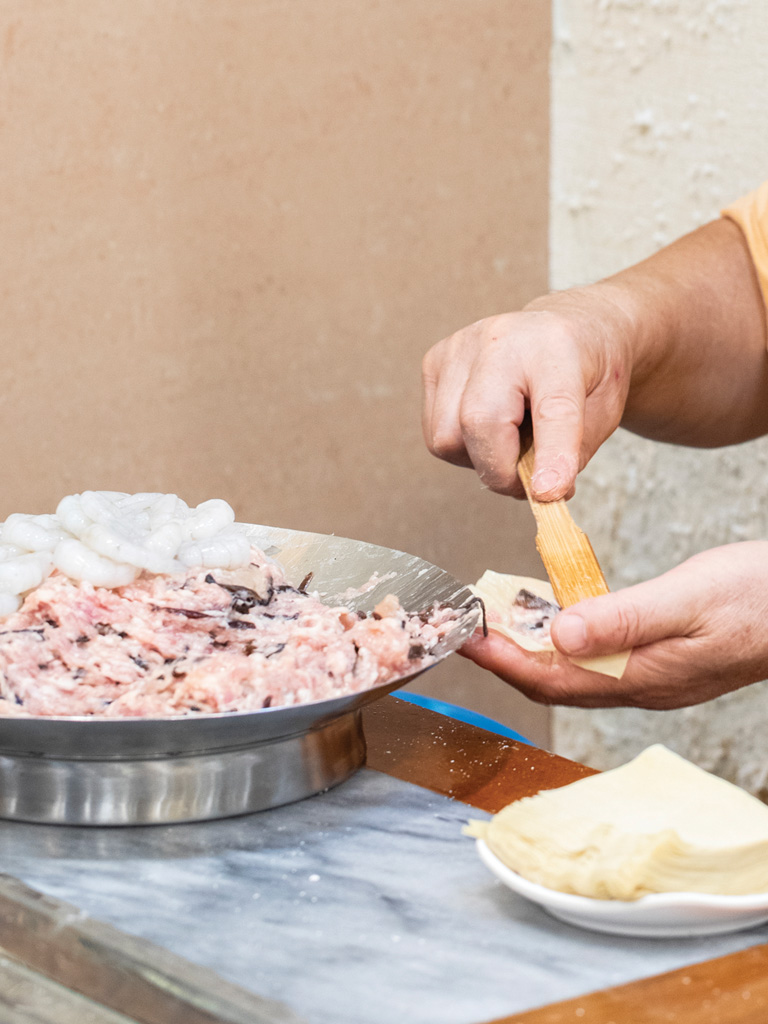

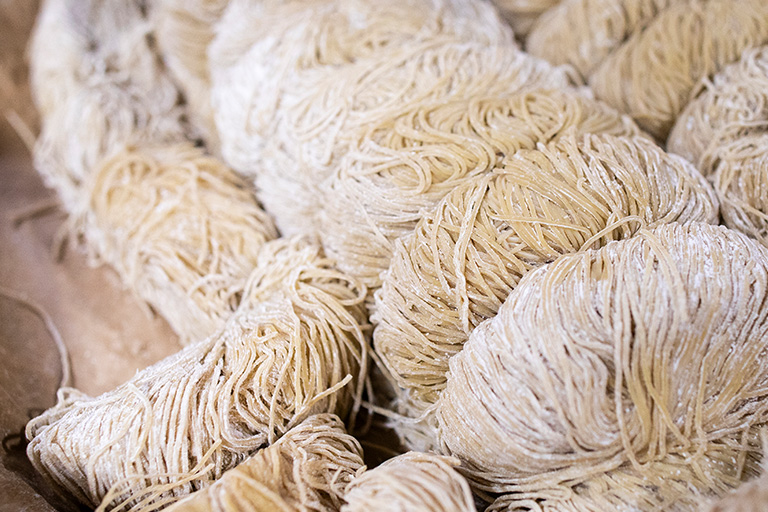
“However, it was the time-honoured family recipe that provided the crucial secret to making the very best bamboo noodles: dealkalisation.”
“Without a mentor, the two brothers studied the recipe and did online research,” Marco explains. However, it was the time-honoured family recipe that provided the crucial secret to making the very best bamboo noodles: dealkalisation. During noodle-making, alkaline water interacts with the protein in high-gluten flour, which increasing the elasticity of the dough, giving the noodles their distinct springiness. However, not everyone enjoys the residual alkaline taste. Therefore, removing alkalinity after kneading the dough is essential.
After experimenting with the recipe for a while, Marco’s uncle opened Chuk Yuen Bamboo Noodles in Guangzhou in the early 2000s, and it quickly became a hit with diners. In 2010, Li Sai Leung and his wife, Maggie Wong Yuen Kwan, set up Kwan Kee Bamboo Noodles in Hong Kong, choosing a bustling spot in Cheung Sha Wan. Li Sai Leung named the restaurant in Maggie’s honour.
Kwan Kee covers approximately 1,000 square feet, and it features an open noodle-making workshop occupying a third of the space that allows passersby and diners to watch the masters in action. Initially, the little eatery was almost exclusively a husband-and-wife effort, with Li Sai Leung making noodles and researching broth recipes while Maggie managed the finances. They also collaborated with local master chefs to experiment with wontons, beef brisket, pork knuckle and more.
However, when they started the business, Li Sai Leung was almost 60 years old. The heavy burden of noodle making would soon shift to his son, Marco.
The secret of hand-kneaded noodles
When he was younger, Marco didn’t like bamboo noodles, detesting the lingering alkaline taste. “It wasn’t until I tried the bamboo noodles made at home that I began to like them. Since then, I have only eaten the noodles made at home. When dining out, I usually go for rice vermicelli or flat rice noodles,” Marco says.
Since taking over the family business, he personally manages the daily home-cooked noodle operation. He takes pride in the authenticity of his noodles, which are made only with high-gluten flour, eggs and a suitable amount of alkaline water and contain no additives.
“In the early stage of my apprenticeship, hand-kneading the dough was the hardest part,” Marco reminisces. “If the flour and eggs are not mixed evenly, it affects the texture of the noodles.” For most noodle makers today, the laborious task of hand-kneading has been taken over by machines.
However, Marco says machines cannot replace the bamboo pole technique. He explains that the rhythmic strikes of the bamboo, powered by human effort, produce noodles that are more springy and palatable than those made by machines. Skilled artisans also use their innate feel of the bamboo to judge the dough’s consistency.
“After mixing the flour and eggs, the dough is relatively loose initially. But after kneading, it becomes firm and springy. When pressed, the fingers should feel a little pain; that’s the best state,” Marco says. After the dough is kneaded, it is left to rest overnight for the crucial process of dealkalisation.
“But I can’t tell you the specifics of this process; it’s a secret,” Marco says mysteriously. The following day, after most of the alkaline taste has gone, the young craftsman uses a machine to roll the dough thinner and cut it into fine noodles. It takes more than 20 hours of work to turn loose dough into springy and delicious noodles.
Each time he kneads the dough with the bamboo pole, Marco typically works with around 10 kg of dough, enough to cook 200 bowls of wonton noodles. When business is good, they sell out within a day.
“In my early 20s, I could finish kneading 10 kg of dough in just 30 minutes. Now, it takes me 40-45 minutes. It’s a physically demanding job,” Marco says.
“He explains that the rhythmic strikes of the bamboo, powered by human effort, produce noodles that are more springy and palatable than those made by machines. Skilled artisans also use their innate feel of the bamboo to judge the dough’s consistency.”
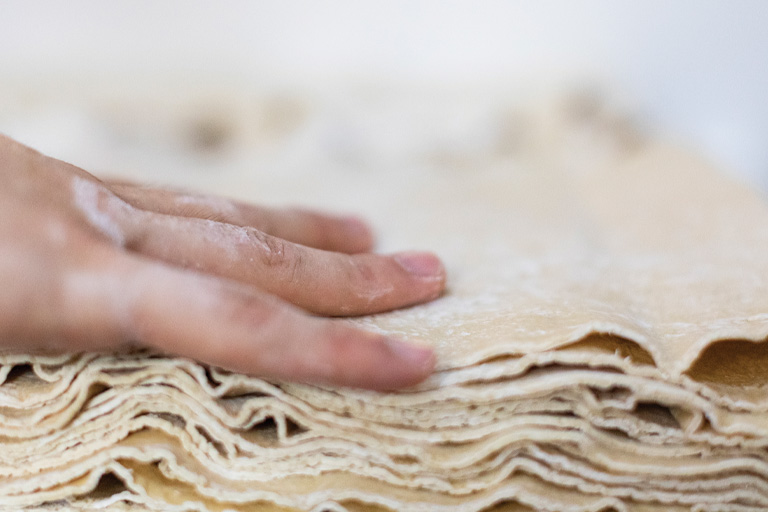
Bringing a youthful twist to bamboo noodles
With the help of the secret family recipe and meticulous craftsmanship, Kwan Kee made it to Michelin’s prestigious “Recommended” list just two years after opening and maintained its position for 13 consecutive years. However, what made Li Sai Leung the happiest was when bamboo noodles were recognised as part of Hong Kong’s “Intangible Cultural Heritage” in 2014.
A handful of bamboo noodles, quickly rolled in boiling water and served in a rich flounder broth with wontons – this is the comfort food that so many older Hong Kong residents remember and love.
Marco mentions that there is still much for him to learn, especially in perfecting the broth. “The broth and bamboo noodles are truly the best companions, and they complement each other,” Marco says. Currently, Kwan Kee’s clear broth is made of roasted flounder powder, dried shrimp heads, monk fruit, liquorice, rock sugar and other ingredients, balancing the roasted fish’s savouriness with a hint of sweetness.
“However, what made Li Sai Leung the happiest was when bamboo noodles were recognised as part of Hong Kong’s ‘Intangible Cultural Heritage’ in 2014.”
Marco admits that wonton noodles have not yet captured the younger market. Yet the key to ensuring the longevity of this traditional craft is to make it appealing to the next generation. So he keeps innovating while partnering with local schools and NGOs to hold workshops so that children can experience the unique process of bamboo noodle making. At the same time, he explores opportunities to export bamboo noodles to overseas markets.
“For over a decade, it has been tough – from making wontons to attending to customers and manning the cashier, I had to do everything,” says Maggie. “But I still love it! My husband and I have always enjoyed eating bamboo noodles. Being able to handcraft the noodles we love gives me a sense of pride.” Her husband has since retired, and their son has officially taken over the family business. Now, mother and son work together to carry on this culinary and cultural legacy.
